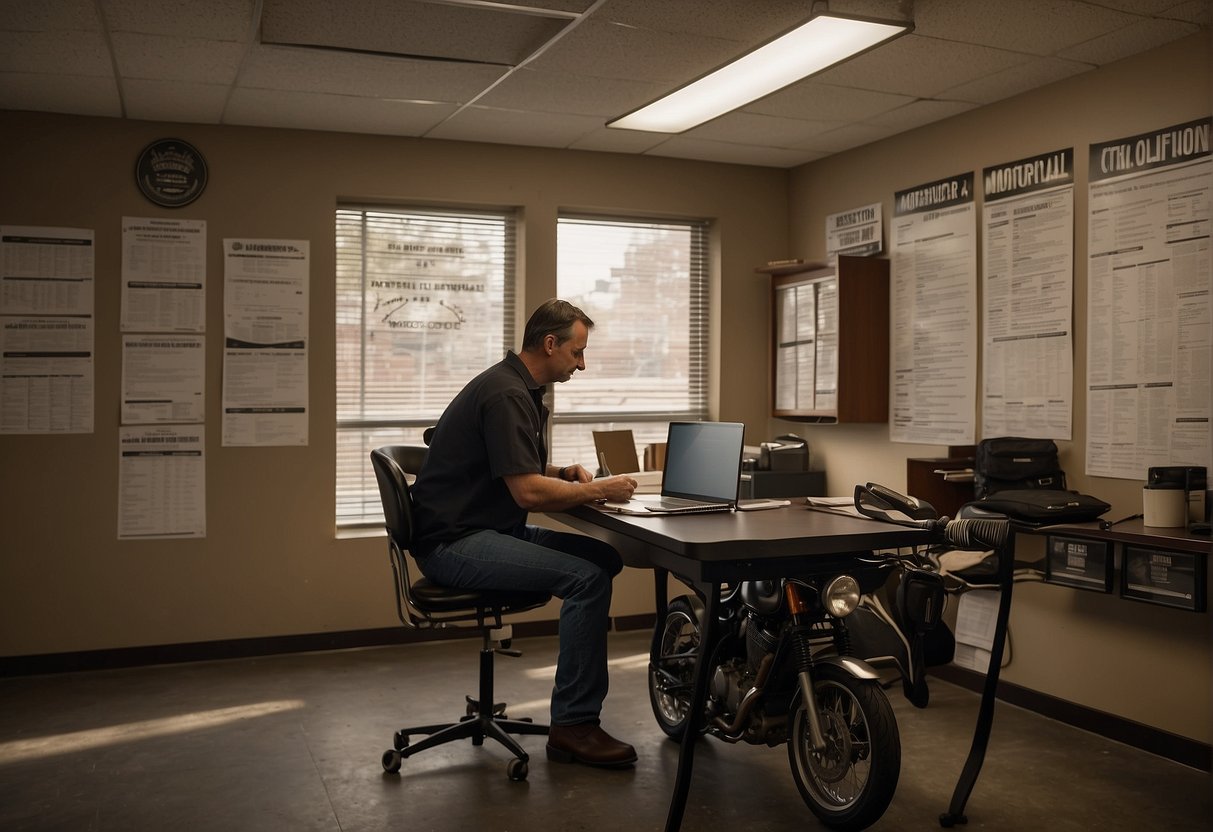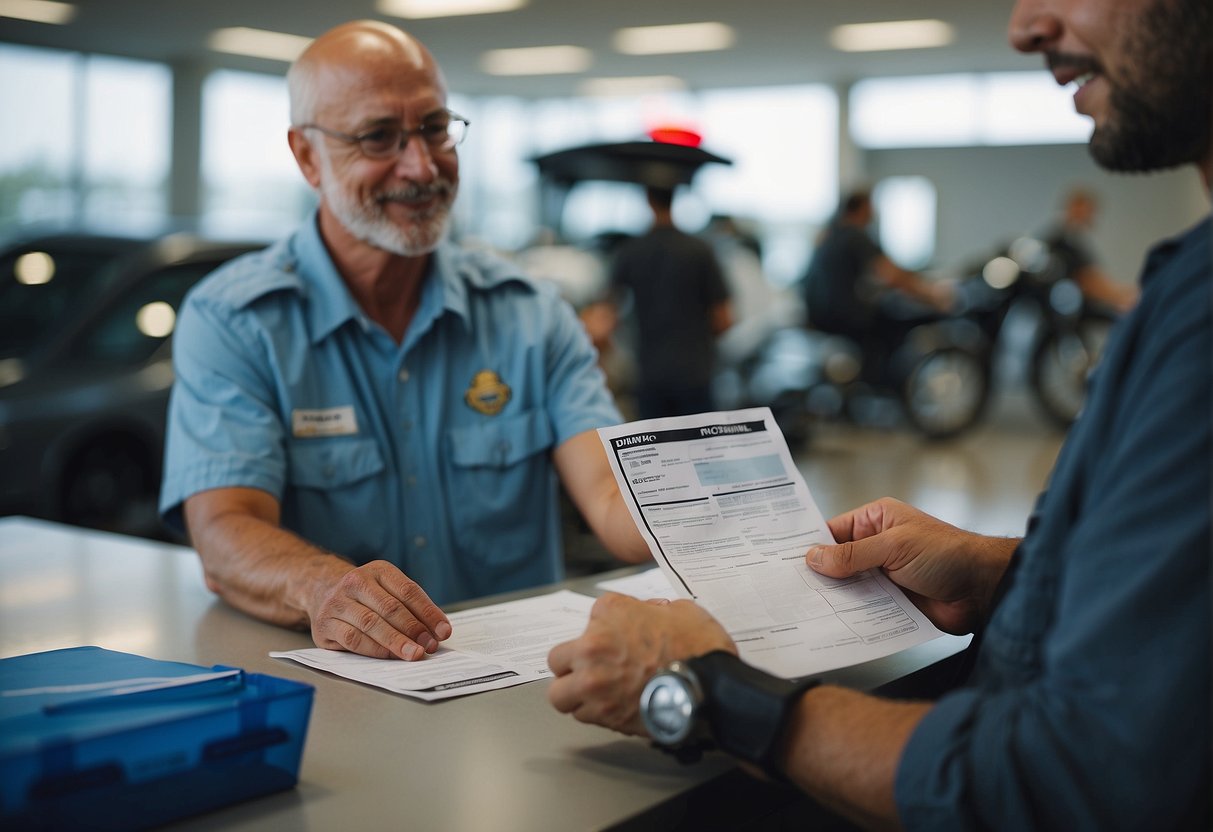Overview of Motorcycle Licensing in Austin

Obtaining a motorcycle license in Austin requires completing a series of steps. First, an individual must hold a valid Texas driver’s license or learner’s permit.
Next, they must complete a motorcycle safety course approved by the Texas Department of Public Safety (DPS). The course consists of classroom instruction and on-cycle training. The course covers topics such as motorcycle operation, basic vehicle control, and hazard avoidance.
After completing the course, the individual must pass a skills test administered by the DPS. The skills test includes a variety of maneuvers such as starting, stopping, turning, and swerving.
Once the individual passes the skills test, they will receive a motorcycle endorsement on their driver’s license. This endorsement allows them to legally operate a motorcycle on public roads in Texas.
It is important to note that individuals under the age of 18 must also complete a driver education course before obtaining a motorcycle license. Additionally, they must provide a car and driver to follow them during the skills test.
Overall, obtaining a motorcycle license in Austin requires completing a motorcycle safety course, passing a skills test, and obtaining a motorcycle endorsement on a driver’s license.
Eligibility and Requirements for Motorcycle License

Obtaining a motorcycle license in Austin requires meeting certain eligibility requirements and fulfilling specific prerequisites. This section outlines the age requirements, education and training prerequisites, and documentation needed to obtain a motorcycle license in Austin.
Age Requirements
To apply for a Class M motorcycle license in Austin, an individual must be at least 15 years of age. However, they may be restricted to operating a motorcycle with no more than a 250 cubic centimeter piston displacement. This restriction can be removed on the applicant’s 16th birthday.
Education and Training Prerequisites
To apply for a Class M motorcycle license in Austin, applicants must complete a motorcycle safety course approved by the Texas Department of Public Safety (DPS). The course includes classroom instruction and on-cycle training. Applicants who have completed the classroom portion of driver’s education may also be eligible to apply for a motorcycle license in Austin.
Documentation Needed
Applicants for a motorcycle license in Austin must provide proof of identity, social security number, Texas residency, and lawful U.S. presence. The DPS provides a guide to acceptable documents for applicants to review. Additionally, applicants must pass a motorcycle written knowledge exam. If an applicant has an out-of-state learner license or permit and would like to transfer to an unrestricted Texas motorcycle license, they must also pass the motorcycle written knowledge exam.
Overall, obtaining a motorcycle license in Austin requires meeting specific eligibility requirements, completing a motorcycle safety course, and providing the required documentation. By fulfilling these requirements, individuals can obtain the necessary license to operate a motorcycle safely and legally on Austin’s roads.
The Motorcycle Licensing Process
Obtaining a motorcycle license in Austin requires passing a written knowledge test, a motorcycle skills test, and a vision exam.
Written Knowledge Test
The written knowledge test consists of 30 multiple-choice questions covering topics such as motorcycle safety, laws, and rules of the road. To prepare for the test, applicants can study the Texas Motorcycle Operator’s Manual, which is available online or in print. It is recommended that applicants take a motorcycle safety course to gain additional knowledge and skills.
Motorcycle Skills Test
After passing the written knowledge test, applicants must pass a motorcycle skills test. The skills test evaluates the applicant’s ability to operate a motorcycle safely and includes exercises such as turning, braking, and swerving. The test is conducted on a closed course and is designed to simulate real-world riding conditions.
Vision Exam
Applicants must also pass a vision exam to demonstrate that they have adequate visual acuity and peripheral vision to operate a motorcycle safely. The vision exam is a simple test in which the applicant reads an eye chart from a distance of 20 feet.
Once an applicant has passed all three components of the motorcycle licensing process, they will be issued a Class M license, which allows them to legally operate a motorcycle on public roads in Austin and throughout the state of Texas.
Motorcycle Safety Courses in Austin
If you want to obtain a motorcycle license in Austin, Texas, you must complete a motorcycle safety course. These courses are designed to teach you the skills and knowledge you need to ride safely on the road.
Basic Rider Course
The Basic Rider Course is a 15-hour course that covers the basics of motorcycle riding. It is designed for beginners who have little or no experience with motorcycles. The course is taught by certified instructors who will teach you how to operate a motorcycle, how to shift gears, how to brake, and how to turn. You will also learn about the different types of motorcycles and the importance of protective gear.
The course includes both classroom instruction and on-cycle training. In the classroom, you will learn about the rules of the road, defensive driving techniques, and motorcycle maintenance. On the range, you will practice the skills you learned in the classroom, such as starting, stopping, turning, and swerving.
Advanced Rider Course
The Advanced Rider Course is a 1-day course that is designed for experienced riders who want to improve their riding skills. The course is taught by certified instructors who will teach you advanced techniques, such as cornering, braking, and swerving. You will also learn about hazard avoidance and how to ride in a group.
The course includes both classroom instruction and on-cycle training. In the classroom, you will learn about risk management, situational awareness, and advanced riding strategies. On the range, you will practice the skills you learned in the classroom, such as quick stops, tight turns, and obstacle avoidance.
Completing a motorcycle safety course is not only a requirement for obtaining a motorcycle license in Texas, but it is also a great way to improve your riding skills and stay safe on the road.
Renewal and Maintenance of Motorcycle License
Renewing a motorcycle license in Austin, Texas, is a straightforward process that can be completed in person, online, by mail, or by phone. To renew a motorcycle license, the applicant must meet certain requirements, such as having a valid driver’s license, passing a vision test, and paying the required fees.
In Texas, motorcycle licenses are valid for six years and must be renewed before the expiration date. The Texas Department of Public Safety (DPS) handles license renewals and provides a grace period of two years after the expiration date. However, it is illegal to operate a motorcycle with an expired license, and the rider may face fines or other penalties.
To renew a motorcycle license in person, the applicant must visit a Texas DPS office and provide the required documents, such as proof of identity, proof of residency, and proof of insurance. The applicant must also pass a vision test and pay the renewal fee.
Renewing a motorcycle license online or by phone is the most convenient option for many riders. To renew a motorcycle license online, the applicant must visit the Texas DPS website and follow the instructions. The applicant must also pass a vision test and pay the renewal fee using a credit card.
To renew a motorcycle license by phone, the applicant must call the Texas DPS and provide the required information, such as the driver’s license number and the renewal notice number. The applicant must also pass a vision test and pay the renewal fee using a credit card.
In addition to renewing a motorcycle license, it is important for riders to maintain their license by following the rules of the road and staying up-to-date with the latest safety regulations. Riders should also consider taking a motorcycle safety course to improve their skills and reduce the risk of accidents.

